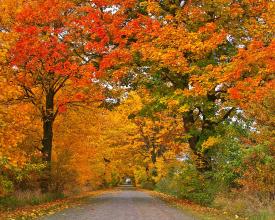DHA eNews - EU Restricts Imports Of Maple Logs & Veneer
The Real American Hardwood campaign needs your support to continue running ads. Many of us have said that the industry needs ads that promote hardwoods on the Magnolia Network, HGTV, etc. The Real American Hardwood Coalition—supported by DHA—recently launched more ads promoting the beauty of real hardwoods. The campaign is on track to reach 100 million consumers by year-end. But, the campaign will require continuous funding to continue to reach consumers. Please see the request for funding for how to contribute.
Despite North America's use of high-temperature processes that reduce any risk, the EU has placed new restrictions on exports of hard maple veneer to Europe. EU countries now require "area freedom" from Davidsoniella virescens, a fungus that infects hardwood trees, for both hard maple logs and sliced veneer sheets. This means that hard maple logs and veneer sheets produced from those logs that originate in NY, VT, MI, WI, and NC cannot be certified for shipment to the EU. DHA is working with the American Hardwood Export Council and USDA staff to get further information and determine next steps.
If you have questions or comments, contact me. I look forward to hearing from you.

Keith A. Christman, President
Decorative Hardwoods Association

Until recently, U.S. hard maple veneer could be exported to the European Union as long as it was certified as kiln-dried, to satisfy the concern over sapstreak disease, Davidsoniella virescens. The EU recently changed this, requiring "area freedom" from the disease for maple logs and sliced veneer sheets. The consequence: maple logs and veneer sheets produced from those logs that originate in NY, VT, MI, WI, and NC cannot be certified for shipment to the EU.
DHA and many other industry associations are participating in the Real American Hardwood Coalition's "Build Your World" consumer marketing campaign. The campaign includes 15-second, 30-second, and 60-second ads on the Magnolia Network, HGTV, Hulu Live, YouTube TV, and more.
DHA is supporting the bipartisan Jobs In The Woods Act to create a fund for nonprofit organizations, state governments, and colleges to use for workforce training in forestry fields, to prepare students for jobs in the U.S. Forest Service and the timber industry.
DHA, Hardwood Federation, Chamber of Commerce, and 32 industry groups are urging the EPA to keep its current standard for fine particles instead of moving to proposed stricter standards. The coalition notes that fires and unpaved roads are major sources of fine particle air pollution that far exceed industry sources.
The Washington Post wrote an informative article about why and how the quality of the furniture sold in the U.S. has deteriorated. Fifty years ago, people expected their furniture to last a lifetime. That furniture was manufactured in the U.S. of domestic plywood or solid wood like cherry, oak, and walnut. Today, most furniture sold in the U.S. is made of Chinese pressboard or plywood. The quality is inconsistent, and the furniture isn't made to last.
Furniture and wood products are two of the 13 sectors of U.S. manufacturing that declined in August. Economic activity in the manufacturing sector has now declined for the tenth consecutive month after growing for 28 months.
The U.S. House of Representatives passed bipartisan bills boosting forest management, addressing the wildfire crisis, and promoting outdoor recreation and access. One of the bills, H.R. 1567, holds federal land management agencies accountable for reducing the amount of fuel for wildfires.
Southern states such as Alabama, Mississippi, and Georgia are now emerging as some of the country's top producers of timber. While lumber production declined during the recession, timber continued to thrive, setting the stage for a new era in the South.
A new initiative from the U.S. Department of Agriculture will award $65 million in conservation innovation grants. Described as the largest clean energy and climate investment in history, the grants will fund new tools, approaches, and technologies to advance the conservation of natural resources on private land.
In eastern Oregon, forest thinning is improving the robustness of older trees. A study on federal lands indicates that thinning helps bring back tree and understory vegetation, creating conditions that help forests bounce back.
A new report from the University of Maryland has confirmed that forest fires are becoming more widespread, likely due to climate change. The report broke down global satellite data and found that wildfires were the cause of 26–29% of global forest loss between 2001 and 2019.
In China, scientists exploring an enormous sinkhole discovered a huge ancient forest 630 feet underground. Researchers believe that the primitive forest could have been home to previously unidentified species of plants and animals.
The showstopper of this year's Leitz Photographic Auction is a custom Leica M6 with a solid gold logo, armored with walnut veneer.
What is the most widely used hardwood throughout Europe?





